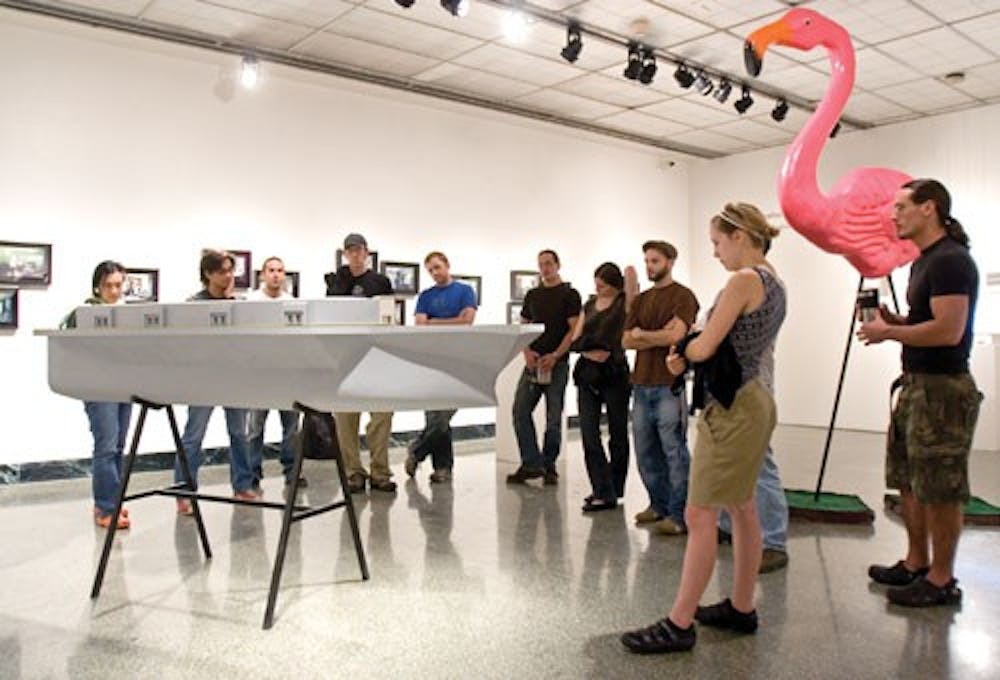Staring resolutely at the camera with bangs covering one eye, a pretty, dark-skinned woman with a stoic expression is posed on the couch. Next to this photograph are the words “I do like things about myself but they seem to be trivial, like my wrists and collarbone.”\nThis photograph was one of many in senior Kerry Stoltz’s Bachelor of Fine Arts thesis project, “Body Languages,” on display in the School of Fine Arts Gallery last week. She said the idea for the project first came to her a year ago and started developing soon after. \nThe theme was women and body image. With the help of her family and a few close friends, Stoltz began capturing through the lens of a camera, producing an honest account of women candidly discussing their bodies. \nThe success of the photographs, accompanied by text explaining the women’s responses, encouraged Stoltz to explore the topic even further. She began including a variety of women, a few of whom were complete strangers that ranged in age from 4 to 80 years old.\nThe results were varied, with some women proclaiming full acceptance of their bodies, while others wished they could change many things.\n“I really wanted to capture a moment of inner reflection, a moment of whether they want to show themselves or not,” Stoltz said. “This isn’t just a celebration of bodies, but rather an awareness and acceptance.”\nStoltz had the opportunity to cultivate such a project through the Bachelor of Fine Arts program, a two-year course of study offered through the School of Fine Arts. \nThe program, intended for students who want to concentrate on just one studio area, such as photography or sculpture, is not only intense and rigorous but highly selective. Although each program has its own set of criteria for admission, all are generally small. Most have 10 to 15 students.\n“We don’t advertise our program,” said Malcolm Mobutu Smith, an assistant professor who helps oversee admission into the ceramics program. “We recruit through the classes and are not looking for a certain number of students each semester.”\nWhen students become part of the B.F.A. program, their required course load increases almost twofold, from 33 credit hours required in the Bachelor of Arts program to 62 hours of studio time. Students must also complete fundamental skills courses as well as the general-education requirements. Many students stay extra semesters to finish the requirements, Smith said.\nThe hefty course load isn’t the only change. Shifting from classroom-oriented instruction, professors become more like mentors instead of instructors, guiding the students through their own, self-constructed projects. \n“There is a big shift in the maturity level of the students,” Smith said. “They go from being told what to do to learning how to develop their own voice with the material. Students have to be self-directed.”\nDepending on their ambition and experiences, students usually apply for the program at the end of their sophomore years or the beginning of their junior years. Applicants must submit a number of art pieces for faculty review and be able to discuss their own work.\nGalo Moncayo, an assistant professor in the sculpture department, said he doesn’t necessarily look for an already developed artist, but rather someone with the potential for growth within the program.\nThe sculpture department is small, with room for six students, and it, too, recruits through classrooms. He said the department looks for the students with craftsmanship and a good work ethics.\nAll students in the programs are given their own studios, to which they have access 24 hours a day. They share a work space with the Master of Fine Arts students and are required to attend weekly critiques, where they discuss each other’s work, Moncayo said.\n“So much of the program is about preparing yourself. It’s not just a school thing and then you’re done. You have to be really committed because the work never really ends,” said sophomore Troy Mottard, a B.F.A. painter.\nAdjusting to the program can be difficult at first, especially for those who may not be used to creating their own projects on a regular basis. Such was the case for Kara Yoder, a senior in the photography department.\n“When I applied, I didn’t really know what I was getting myself into. It was a big adjustment to come up with my own stuff and not have assignments,” Yoder said.\nNow in her second semester, Yoder said she is much more comfortable with the structure of the program. With graduation set for December, she is beginning to work on her own thesis project – the final task for the B.F.A. students.\nWithout rules or limitations, students have complete freedom in creating their theses. By the time they are creating a thesis, they are expected to have reached the pinnacle of their growth in the program. And though the pressure is high, most of the students are ready to share with the public what they, as artists, want to say. \nEven though Stoltz’s thesis is complete, she plans to continue with her work.\n“The B.F.A. program is really what you make of it,” she said. “I’ve devoted the past year to this project, and I’m so thankful that I did. I need a bit of a breather, but I’m excited to keep going.”
The Fine Art of getting a B.F.A.
Students pour hours of dedication, labor and emotional investment in the prestigious fine arts program

Get stories like this in your inbox
Subscribe





